Toshiba Satellite U845W Ultrabook Review: Going Wide at 21:9
by Dustin Sklavos on October 16, 2012 12:01 AM ESTDisplay Quality
While the display of the Toshiba Satellite U845W is arguably it's selling point, I regret to inform you that it is unfortunately still a TN panel. The 1792x768 resolution makes it much improved for productivity purposes (making it easy to edit two documents side by side, something Toshiba goes out of their way to make even easier by including software that resizes windows to suit the wider display) and even the movie we use to test battery life looked a bit better since no letterboxing was occurring, but contrast and color are still middling.
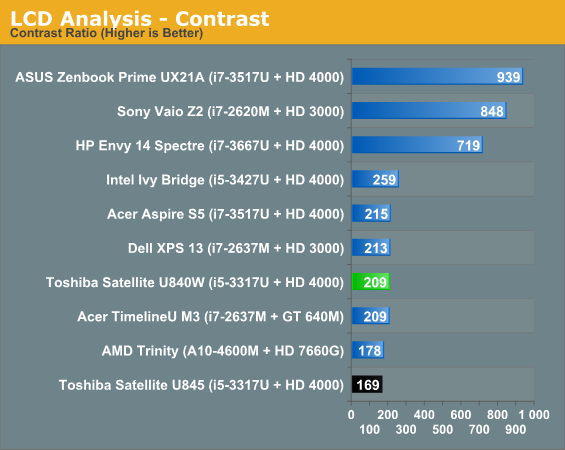
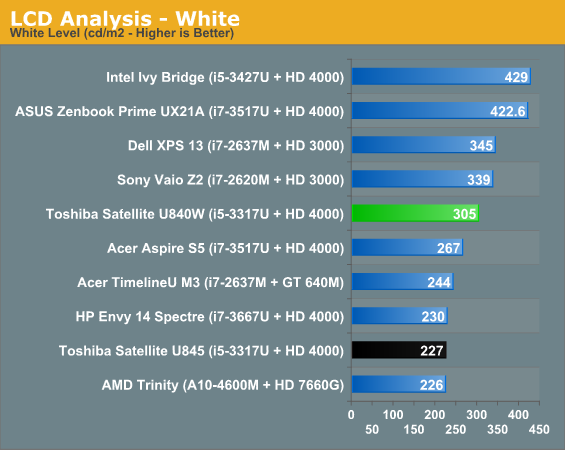
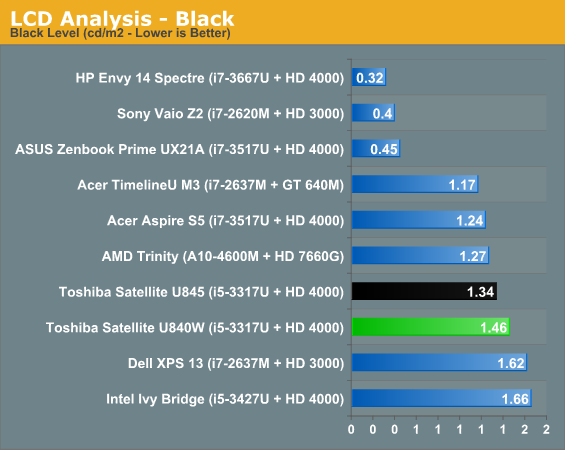
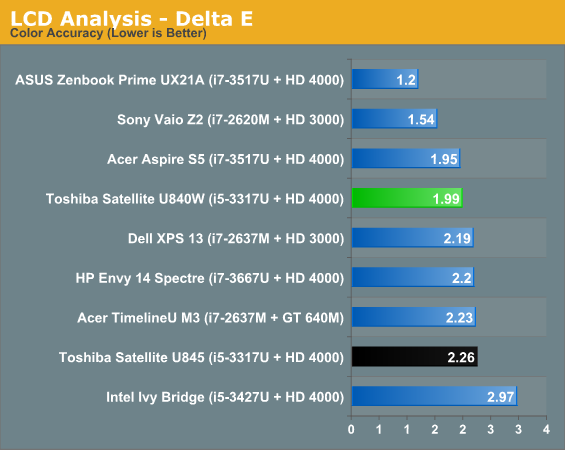
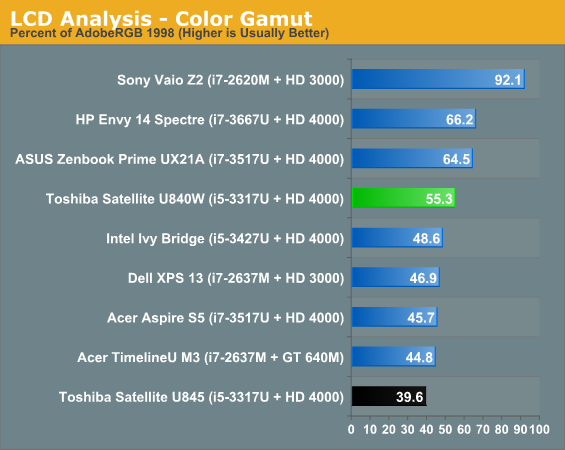
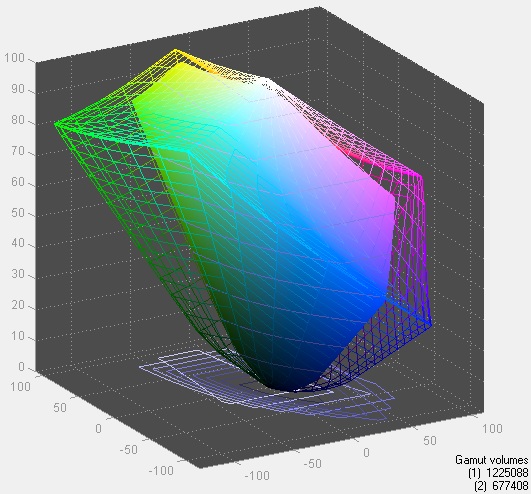
You can see it's not quite as bad as TN panels typically are, and dpi is actually bit improved from a typical 14" 1360x768 display (remember that this one is actually shorter than 14" panels usually are), but it's still not a huge winner. It's very bright, but the high black level takes its cut from the contrast ratio. Viewing angles are average for a TN display, and I feel like this resolution would be better served by an IPS display (then again, every resolution would be better served by an IPS display.)
Battery Life
What I'm particularly curious about is, given that everything else is equal between the Toshiba Satellite U845W and the more traditional Satellite U845, how much running time is sacrificed in the switch to a slightly larger, higher resolution display?
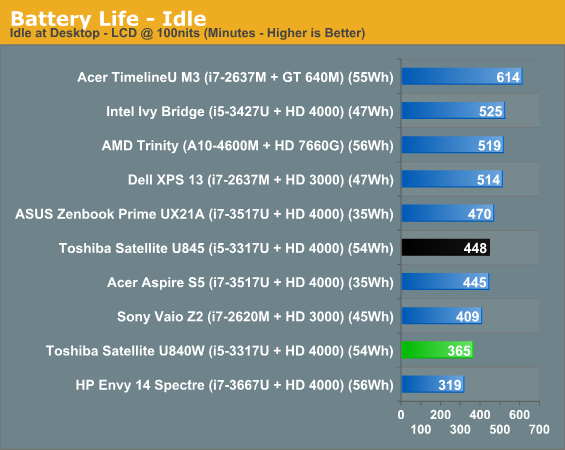

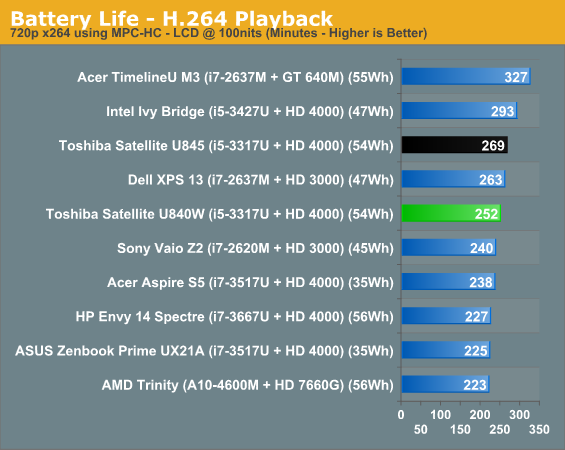
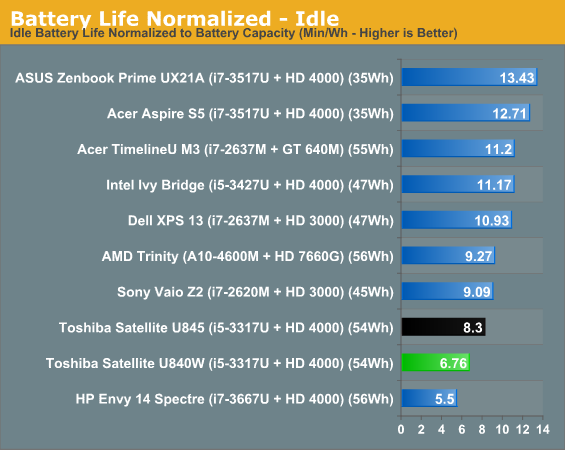
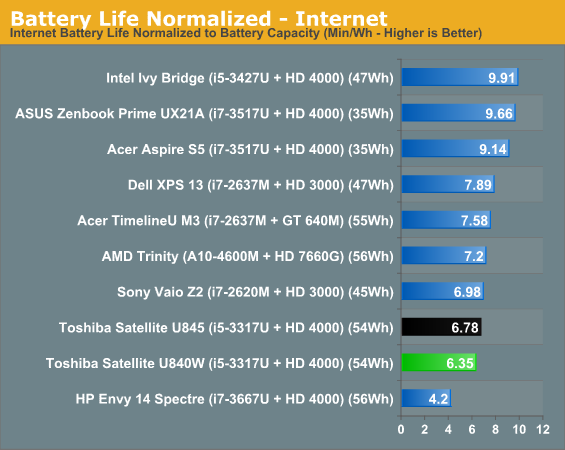

Happily, while the U845W takes a bit of a bath in idle usage, the differences in actual productive use are smaller to the point of mostly being negligible. That's good news since the substantially wider display is much better for productivity than the usual 1366x768 14" panel tends to be.
Heat and Noise
I'm particularly pleased with how Toshiba designed the cooling system of the Satellite U845W. Ultrabooks and even just more portable notebooks seem destined to be used on your lap, yet vendors keep putting fan intakes on the bottom, waiting to get suffocated. The U845W doesn't make that mistake; the entire back of the notebook is ventilated while the bottom is one solid piece of plastic with no ventilation to worry about stuffing up. And because the ultrabook is so wide, that means a substantial amount of surface area is being opened up for airflow.

Load temperatures around 80C are basically unheard of in an ultrabook, where thermals are routinely sacrificed for the form factor. This is really quite good, as the surfaces of the U845W barely get warm, and even the fan speed remains relatively low. The U845W runs cooler and quieter than most any other ultrabook I've tested, and Toshiba should be proud of themselves.










57 Comments
View All Comments
kevith - Tuesday, October 16, 2012 - link
No thanks.Belard - Tuesday, October 16, 2012 - link
This is SOOOO Amiga 2000/4000 and Commodore 64.Exodite - Tuesday, October 16, 2012 - link
To be fair though, the Amiga at least ran much better aspect ratios.StevoLincolnite - Tuesday, October 16, 2012 - link
Would have had me on board if:* No TN panel. IPS, anything IPS, even E-IPS or even VA would be better.
* Double the 768 vertical resolution as it is painful regardless of how wide a panel is.
* Decent Graphics (Refuse to use Intel graphics after the last several decades of poor IGP's with even worse drivers which are still crap today.) or went with AMD's trinity.
* Better network connectivity.
As for peoples qualms about the wider aspect, to me it's fantastic but I also game in eyefinity so I'm used to having extra wide screens.
Unfortunately, companies like Toshiba would never bother reading the comments here at Anandtech to see what people want, instead we get the same let-downs from all manufacturers. :(
AssBall - Tuesday, October 16, 2012 - link
I'm sure Toshiba does care about your comments. Considering 0.01% of their customers read Anandtech, and 1% of those feel the same way you do. It's definitely folks like you who who want a $3500 dollar laptop who drive their billion dollar worldwide mobile computing roadmap.Belard - Tuesday, October 16, 2012 - link
Am I missing something here? I really don't see much of a reason for this odd-ball shaped screen, already 16:9 (standard) screens SUCK! 16:10 is better.A more usable resolution in 1920x1080, easily possible on todays 13~14" displays.
You can STILL work on documents side by side WHILE having some height to work with and not get that tunnel vision feeling.
tomeklutel - Tuesday, October 16, 2012 - link
Widescreen laptops just doesn’t make sense. When we spend most of our time working with spreadsheets, text documents, and web browsers, we want a higher resolution with a longer page. Widescreen laptops are actually lower resolution and cheaper to manufacture, so largest companies were convincing that 16:10, then 16:9 is the best format for your eyes. Lot of business people and heavy users still prefer 4:3 screen. Join our community to show your demand for bringing back 4:3 screens to people - https://www.facebook.com/pages/Bring-Back-43-Lapto...Paulman - Tuesday, October 16, 2012 - link
But if you make it WIDE-screen ENOUGH, then all of a sudden you can fit two windows side by side as you work or you can have one big window and still enough screen real estate on the side to have your IM window open, or some video going on the side, or CPU monitor stuff, etc.It may not be the most common use scenario, but for some people they might really get a lot out of it. It sounds pretty interesting and kind of attractive to me (I just tried using two windows side by side on my 16:9 HDTV I use as my main monitor and it works pretty well. I'm typing this comment on the right while a Starcraft 2 live video stream with chat box is going on on the left).
The real killer use-case for this would be when you need to write or edit a document while doing research on the Internet, or working with some crazy-wide Excel spreadsheet, etc. Those kinds of people would be REALLY interested in this kind of ultrabook.
knedle - Tuesday, October 16, 2012 - link
I think that there is one big difference between your scenerio and this netbook.You have HDTV monitor, and this notebook has low resolution monitor, which in fact makes many other things difficult. For example web browsing. Websites aren't wide, they are long in terms of height and imagine how much scrolling it's gonna to be on 768 pixels high monitor.
DanNeely - Tuesday, October 16, 2012 - link
Andrew Cunningham reviewed the U845W for Ars Technica last month. The problem is that most websites (and applications) really want to be at least 1024 wide so it didn't work out that well. H was interested in trying the same thing at 2100x900; which would be wide enough to make side by side generally workable and have a halfway decent vertical resolution as well.http://arstechnica.com/gadgets/2012/09/putting-the...